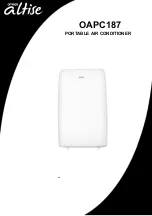
5168276-XIM-B-0216
Johnson Controls Unitary Products
37
Sequence Of Operation
Cooling Sequence Of Operation
NOTE:
For more in-depth sequence of operation of the
Simplicity® SE control please refer to LIT-12011950 on
www.upgnet.com under Product Center \ Equipment
Catalog \ Commercial Products \ Zoning Systems and
Controls.
For ZF units, a "Y1" call for the first stage of cooling is passed to
the Unit Control Board (UCB) which then determines whether
the requested operation is available and if so, which
components to energize. With a "Y1" call for first stage cooling
the UCB will determine if a first stage cooling output is valid as
long as all safeties and time-delays allow a C1 output for
cooling. The C1 relay on the UCB will close and send 24 volts
to the M1 relay starting the first stage compressor and also
energizing M4 relay starting the associated condenser fans.
During any call for fan or cooling the FAN output on the UCB
will energize the M3 relay starting the supply fan.
If a Y2 call is present it is passed to the Unit Control Board
(UCB) which then determines whether the requested operation
is available and if so, which components to energize. With a
"Y2" call for first stage cooling the UCB will determine if a
second stage cooling output is valid as long as all safeties and
time-delays allow a C2 output for cooling. The C2 relay on the
UCB will close and send 24v to the M2 relay starting the second
stage compressor also energizing M6 relay starting the
associated condenser fans. During any call for fan or cooling
the FAN output on the UCB will energize the M3 relay starting
the supply fan.
Continuous Blower
By setting the room thermostat fan switch to "ON," the supply
air blower will operate continuously.
Intermittent Blower
With the room thermostat fan switch set to "AUTO" and the
system switch set to either the "AUTO" or "HEAT" settings, the
blower is energized whenever a cooling or heating operation is
requested. The blower is energized after any specified delay
associated with the operation.
When energized, the indoor blower has a minimum run time of
30 seconds. Additionally, the indoor blower has a delay of 10
seconds between operations.
No Outdoor Air Options
When the thermostat calls for the first stage of cooling, the low-
voltage control circuit from “R” to “Y1” and “G” is completed.
The UCB energizes the economizer (if installed and free cooling
is available) or the first available compressor
*
and the
condenser fans. For first stage cooling, compressor #1 is
energized. If compressor #1 is unavailable, compressor #2 is
energized. After completing the specified fan on delay for
cooling, the UCB will energize the blower motor.
When the thermostat calls for the second stage of cooling, the
low-voltage control circuit from “R” to “Y2” is completed.
Compressor #2 is energized, provided it has not been locked
out, and condenser fan motor #1, and condenser fan motor #2
remain energized. (If the ambient temperature is above 60ºF.)
To be available, a compressor must not be locked-out due to a
high or low-pressure switch or freezestat trip and the
Anti-
Short Cycle Delay (ASCD)
must have elapsed.
These units utilize a lead-lag feature that results in an equal
amount of run hours on all compressors, thereby extending the
life of the compressors. This feature works as follows: If the
thermostat requires for more than one stage of cooling, the
currently off compressor with the least number of run hours will
be the next to be energized. When the thermostat requires
fewer stages of cooling, the currently running compressor with
the most run hours will be the first to be de-energized.
Economizer With Single Enthalpy Sensor
When the room thermostat calls for “first-stage” cooling, the low
voltage control circuit from “R” to “G” and “Y1” is completed.
The UCB energizes the blower motor (if the fan switch on the
room thermostat is set in the “AUTO” position) and drives the
economizer dampers from fully closed to their minimum
position. If the enthalpy of the outdoor air is below the set point
of the enthalpy controller (previously determined), “Y1”
energizes the economizer. The dampers will modulate to
maintain a constant supply air temperature as monitored by the
discharge air sensor. If the outdoor air enthalpy is above the set
point, “Y1” energizes compressor #1.
When the thermostat calls for “second-stage” cooling, the low
voltage control circuit from “R” to “Y2” is completed. The UCB
energizes the first available compressor. If the enthalpy of the
outdoor air is below the set point of the enthalpy controller (i.e.
first stage has energized the economizer), “Y2” will energize
compressor #1. If the outdoor air is above the set point, “Y2” will
energize compressor #2. If Y2 brings on compressor #1 and
this condition remains for more than 20 minutes, then
compressor #2 will be energized until the thermostat is
satisfied.
Once the thermostat has been satisfied, it will de-energize “Y1”
and “Y2”. If the compressors have satisfied their minimum run
times, the compressors and condenser fans are de-energized.
Otherwise, the unit operates each cooling system until the
minimum run times for the compressors have been completed.
Upon the final compressor de-energizing, the blower is stopped
following the elapse of the fan off delay for cooling, and the
economizer damper goes to the closed position. If the unit is in
continuous fan operation, the economizer damper goes to the
minimum position.
Economizer With Dual Enthalpy Sensors
The operation with the dual enthalpy sensors is identical to the
single sensor except that a second enthalpy sensor is mounted
in the return air. This return air sensor allows the economizer to
choose between outdoor air and return air, whichever has the
lowest enthalpy value, to provide maximum operating
efficiency.
















































